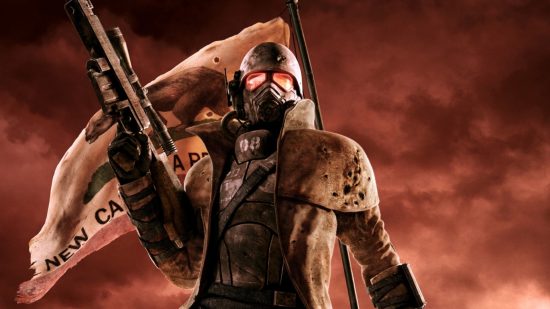April 12, 2024: With the launch of the Fallout TV show, we’re taking a trip down memory lane to reshare some of our classic Fallout coverage. This post was originally published on October 4, 2017.
One of the most memorable quests in Fallout New Vegas is called Come Fly With Me, where you launch a rocket from the REPCONN test site. Once you have gathered the supplies needed to fix the missile, you are treated to a cutscene of the rocket blasting towards the sky, backed by Richard Wagner’s rousing classical song, Ride of the Valkyries. Obsidian put extra effort into making this sequence look, sound, and feel as good as possible.
Lead designer Josh Sawyer wanted to see how it looked for himself once it was finished. But, unfortunately, his viewing was rudely interrupted by a tap on the shoulder – an NPC really wanted to talk to him about bottlecaps.
The NPC, Malcolm Holmes, had trekked across the Mojave desert for this chinwag, like some die-hard post-apocalyptic pilgrim. “Bethesda’s engine allows you to mark a character as persistent, which means they can be active no matter where in the world the player is,” Sawyer tells me. “So you can have bounty hunters tracking you, you can have guys obsessed with bottlecaps following you, you can do all sorts of stuff like that. Bethesda’s tech allowed us to do a lot of stuff we haven’t been able to before.”
When Malcom showed up, Sawyer was completely taken by surprise, it being one of the unexpected consequences that comes with leveraging Bethesda’s engine. “It was like ‘Holy shit, dude, how did you get in here?’,” he says.
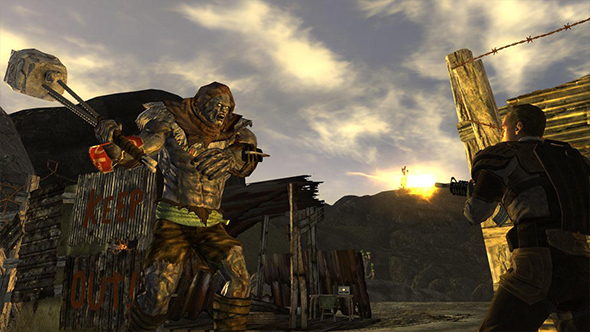
In an attempt to cut down on the times where these emergent moments turn from funny anecdotes into annoying interruptions, Obsidian crafted some rules. One of these rules stopped NPCs from following you into New Vegas proper, making the bright lights of the irradiated gambler’s paradise feel like a safer haven. In a simulated world like New Vegas’s, though, even a seemingly simple rule like that can have unforeseen results.
“I had these Legion assassins after me for a long time, and I was just never in a part of the map where they could get to me,” Sawyer recalls. “So they were just hovering on the east side of the map. Late in the game, you have to go to the Eldorado Substation for something, and I went to the 188 [trading post] and rested. All of the mattresses are down below, so I rest there, and I wake up and hear all hell breaking loose – people are dying, body parts are falling over the side of the bridge. I go up and find these Legion assassins have caught up to me.
“Because this is late-game, there are NCR heavy troopers out there with machineguns and power armor, and all the people that are there are NCR allied, so they’re fighting alongside the NCR troopers. So I was like this sleepyhead late riser. Everyone was dead except one Legion assassin. I killed him and looked around – it was just carnage. Vendors were dead, all the NPCs were dead, and I was just like ‘Well, gotta get going’.”
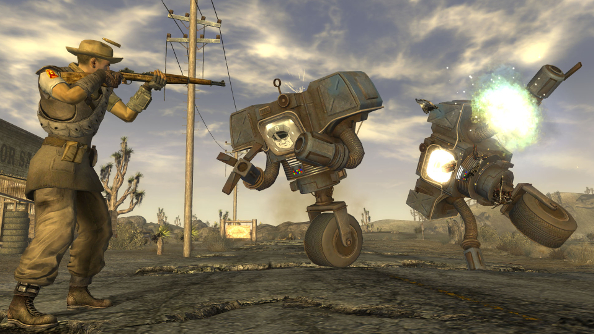
It is likely that you have similar memories of Fallout New Vegas. Games built in Bethesda’s Gamebryo engine are often criticized for their roughness – the bugs, the disappearing NPCs, and the others who unceremoniously die when you are not around – but it is that rawness that makes the games created in it so memorable. One of my personal favorite moments from Skyrim was when I robbed a shopkeeper blind – literally, because I placed a bucket over his head so he could not see me pocketing his wares. These worlds are built on top of a simulation that sometimes feels barely stitched together and yet, somehow, it is even more entertaining when it unwinds, because the stories created by that mayhem are unique to you.
Of course, Fallout 3 had already acted as an incredible anecdote generator not long before New Vegas launched, so Obsidian had the terrifying task of taking that template, harnessing the carnage of a simulated world, and layering on new systems, all in 18 months. “At the time, it was daunting,” Sawyer admits. “For a long time we didn’t really know the technology very well. Because we weren’t going to a new renderer or anything, it was basically like ‘Well, this is Fallout 3, but not as good’ – that was my fear, that people were going to say it was Fallout 3, but nothing was better about it. The whole team put a lot of effort into thinking through how the factions behave, how they interact, and how the world looks, the reasons for why things are laid out the way that they are. I think, when the game launched, people just didn’t notice a lot of that stuff.
“That was a little frustrating at first, because if you’re just playing the game for five to ten hours you’re just like ‘Oh, it’s like Fallout 3, whatever’. One of the things that does make me happy is, over the years, people are starting to notice a lot of the details that the world builders put in, the writers put in, the quest designers put in, creating reactivity. It’s stuff you might not even notice in a single playthrough, but on multiple playthroughs – and there are people who have over 1,000 hours on Steam – they start to see, like, wow, there really is a tonne of stuff you can do in this world that is meaningful in a reactive sense.”
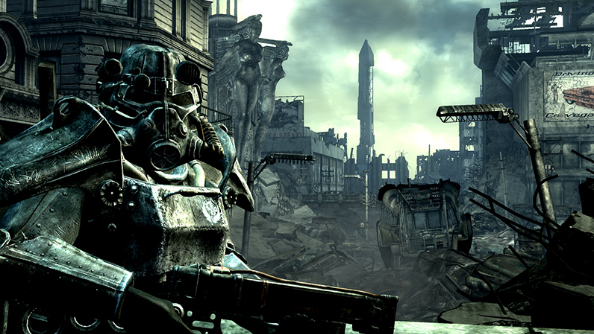
The team had a monumental workload in that short development time. They had to get to grips with new development tools, write 65,000 lines of branching dialogue, design quests, create characters, improve the mechanics – for example, adding an aim-down-sights mode for guns, creating a faction system, disguises, and more – and even build the world.
Speaking of which, it was a trip to Vegas itself that kicked off the creation of Fallout’s casino wonderland. “John Gonzalez was our creative lead and was really interested in classic Vegas,” Sawyer says. “I was more interested in the Mojave Desert, so I rode my motorcycle around Mojave and went out to Red Rock, and went around a lot of the old towns that ended up being in the game, like Goodsprings. That was just to get a feel of the desert.”
The trip generated a bunch of reference photos so the team could try to capture the feeling of Vegas and the surrounding area; all arid, desolate, and expansive. The trick was to mimic that while creating a play space that is around 1/60th of the scale. “We got real satellite data off the internet and were able to import it into the game and reduce it down,” lead world builder Scott Everts explains. “The problem was, as I reduced it, its height variance was huge, so we had to squash it down both ways, flatten down a lot of it. Then we had to add some noise to undulate it a bit. There was a lot of fussing. I was working on it for weeks and weeks.”
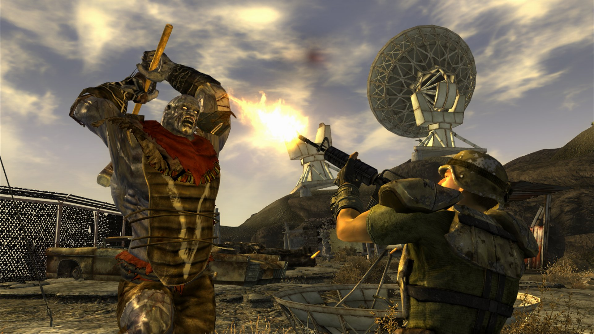
“The Colorado River was pretty funny, because we scaled it down and everything seemed to feel pretty good in terms of traversal, then you go to the Colorado River and you could jump across it,” Sawyer adds with a laugh. “The scale was reduced down so much, so Scott had to do some surgery and kind of expand the Colorado River and Lake Mead so it wasn’t just this puddle.”
To evoke the feeling of a place in a simulacrum a fraction of its size was no easy job, but Obsidian found it helped to imbue the game world with the personality of the real location – the decadence of Vegas as well as the quaintness of some of the surrounding area. “I don’t know if this is true any more but, for a long time, Nipton was where everyone from Vegas went when they wanted to buy a lottery ticket,” Sawyer remembers. “So we had someone working on the team, Fryda Wolff, who’s now a voice actor – her dad went to Vegas and every week he would drive down to Nipton to get lottery tickets. In the game, the way we represented that was you come up to Nipton and Oliver Swanick runs out and he’s like ‘Yeah! I won the lottery!’”
Obsidian are some of the best in the business at this stuff – making a place feel alive, that it has a history. Every person and location in that world feels lived in, despite the fact that almost everything there died in nuclear fire. Every house tells a story. That environmental storytelling works with the emergent stories to sear New Vegas into your mind as a series of memories. Take Malcolm Holmes, that bottlecap-obsessed resident of Obsidian’s post-apocalyptic wasteland – when you meet him, he tells you he has retired from the bottlecap collecting business. Yet, if you react to him tapping you on the shoulder by taking him out (you brute!), you will find six star bottlecaps on his corpse. He was lying to you, but you’d never know it if you didn’t kill him or pick his pocket. That knowledge doesn’t change anything – it simply adds flavor to the story of one minor character. Little things like that make NPCs feel like they have a past, that they harbor secrets, and that their sole purpose isn’t to sprint across a map in order to ruin your cutscene. In turn, it helps to sell the idea that the world is not reliant on you, that life continues when you are not around.
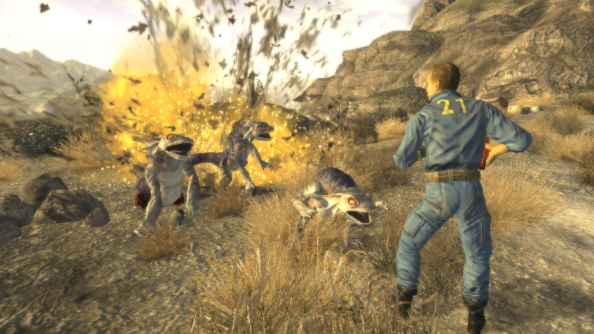
“One of the things about that game is it would have been a lot different if it was PC only,” Everts recalls of the world design. “We had a lot of plans early on. Like, ‘Here’s where the water is stored, here’s where the farms are, here’s where the government is centralized’. We had it all planned out – it wasn’t just a bunch of random stuff. Then we had the whole thing of how the factions interact with each other. Even ‘How does the water get here?’ Because that’s important – those are the things a lot of people don’t think about.
“We could have gone further with that. We had to simplify, so we had less stuff that would bog down the game engine. I was more happy with the DLC because by that time we knew what would work and what wouldn’t. It was also focused, laser sharp, so we could spend more time on it. The wasteland, I would have laid it out differently – it would have been more separate zones I think, put a big wall around the whole thing and you just see the big tower and it’s a bunch of little zones. We would have had fewer performance issues. We did break it up a bit, but from my point of view it was a performance-related game and we had to fix things.”
In fact, it was in making sure the game worked on console that led to Freeside and the suburbs around Vegas being broken up into its own zone. It just would not have run otherwise. Unfortunately, it is simply a fact of modern game creation that: developers go into a project with hundreds of ideas in their head, but have to scale things back in order to make it, you know, work. Additionally, some things might sound like a good idea, only to turn out awful when implemented. These typical design problems were exacerbated for New Vegas’s team because of the tight 18-month window they had to ship the game.
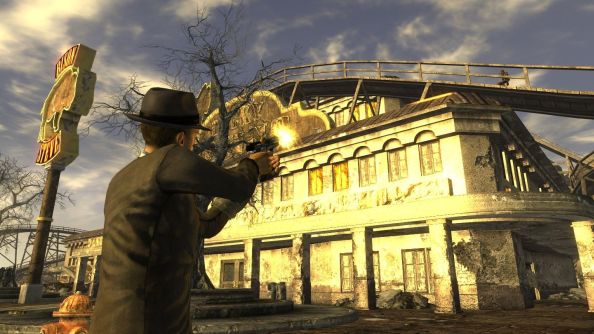
“If you choose to make one aspect of the game more complicated, then it helps to roll back on other stuff,” Sawyer explains. “For example, one thing that would’ve been smart of me to cut are disguises in New Vegas. Faction outfits, which were cool but very time consuming. In retrospect, they’re really cool, I really like them, but they’re buggy as hell and they took a long time. Any developer who is like ‘Hey, we’re going to do this thing in the game that’s very complicated and reactive’, the best way of managing the risk for that would be to look at other things that are potentially complicated and reduce the complexity of them. It’s triage.”
There is an old game developer saying that goes ‘a game is never finished, it just ships’, and that was certainly the case for New Vegas. So much so that Sawyer felt compelled to carry on working on it after the launch, using his personal time to build one of the game’s most popular mods, JSawyer’s mod. Sawyer says the desire to build the mod, which adds a host of balance tweaks and cut content, came from personal taste. He played the first Fallout in college and ended up working at Black Isle just after Fallout 2 shipped, in the hope of creating a traditional sequel, hardcore difficulty and all. Of course, that never happened, and he did not get to touch the series until Bethesda approached Obsidian for New Vegas.
“We had enough to do during the project that I wasn’t wanting to make the team indulge my whims for personal taste,” Sawyer laughs. “There were also certain things technically, from a patching perspective, that were either technically impossible for us to do – due to how the DLCs and the base game interacted – or they were just prohibitively expensive, because patching on consoles was a costly process. So after everything was wrapped up and everything was done, I was like ‘Ah, you know what?’ I downloaded the game at home to see how it actually plays and just kind of tuned it the way I wanted to tune it, then there were some bugs we couldn’t fix for technical reasons. So I fixed them, cleaned things up, then fell into a bunch of other stuff, like there’s a bunch of unused, unique armor, so I started filling that stuff out. Tuning is a never-ending process, but in New Vegas there was a particular disconnect [with the] style of game overall because I had come into Black Isle wanting to make Fallout 3, which in my mind would have been a much more difficult game.”
Speaking to a room full of Obsidian developers, you can tell there is more to it than that, though. While the development process was brutal, New Vegas was clearly a special project for them all, just as it is for the game’s many fans. Listening to them talk and laugh amongst themselves as they recall moments during the game’s development, it is clear that they are proud of what they achieved in such a relatively short period of time. In many ways, the passage of time was like Obsidian’s own impolite NPC, slowly trekking towards them like a relentless machine as they tried to get ready for the launch.
